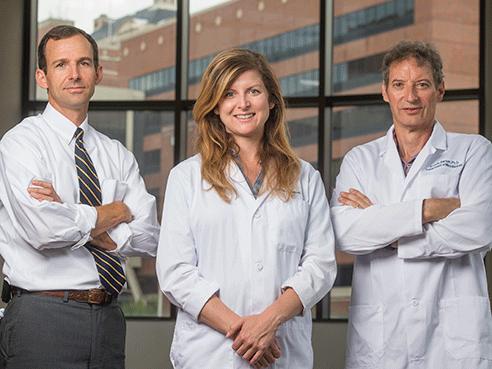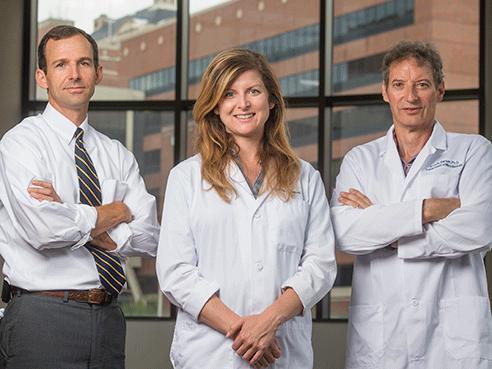
BIRMINGHAM, Ala. – In a study of children with brain shunts at Children's of Alabama, a University of Alabama at Birmingham investigational biomarker outperformed the current "gold standard" test for detecting bacterial infections in the shunts.
This is the second potential diagnostic application for the biomarker, say Scott Barnum, Ph.D., professor, and Theresa Ramos, Ph.D., research associate, both of the UAB Department of Microbiology. The biomarker has already shown the ability to distinguish viral meningitis from bacterial meningitis. This is valuable because patients with viral meningitis usually get better in several weeks, while bacterial meningitis can kill within hours. Bacterial shunt infections are also potentially life-threatening and may require surgical removal of the shunt.
A quick and accurate test for bacterial infection in brain shunts or meningitis would improve the quality and efficiency of patient care and patient outcomes. Such a test would also lower health care expenses by avoiding needless hospitalization and treatment. The UAB investigational biomarker has a pending international patent related to immunodiagnostics.
The shunt study, which was headed by senior author James Johnston Jr., M.D., a UAB assistant professor in the Division of Pediatric Neurosurgery, Department of Neurosurgery who treats patients at Children's of Alabama, and first author Ramos, was recently published in JCI Insight.
Ventricular brain shunts — a drain from cavities in the brain to the abdomen — are the most common procedure to treat hydrocephalus, a condition of excess cerebrospinal fluid in the brain that affects 1 million people in the United States. The national health expenditures for shunts run about $2 billion a year.
Studies have shown that one-eighth of shunts fail within 30 days, more than a quarter fail within a year, and the rates of shunt infections range from 5 to 12 percent. The current standard laboratory tests to identify bacterial infection cost more than $1,000 per shunt tap at most U.S. hospitals, and many shunt patients are repeatedly tapped — some only twice, but others as many as 10 to 15 times in an effort to detect infection and identify the pathogen.
Diagnosing the difference between shunt failure and shunt infection is difficult because of overlapping clinical signs, and even when infection is present, the current tests fail to detect bacteria in culture 25 to 30 percent of the time.
The UAB and Children's of Alabama researchers tested the UAB biomarker in a prospective study that enrolled 248 patients over two years. They found that levels of an immune system protein called soluble membrane attack complex, or sMAC, were elevated about 100-fold in cerebrospinal fluid from patients with shunt infections as compared with patients with no infection.
Using appropriately adjusted cutoff values for maximum sensitivity and specificity, sMAC was able to detect 14 of 15 infections in the 248 patients, while the current diagnostic gold standard of bacterial culture was less accurate, detecting only 11 of the 15 infections. At the best cutoff value, the test had "excellent diagnostic capability," the researchers said, with a sensitivity of 93 percent and a specificity of 86 percent.
Ramos, Barnum and Johnston are co-inventors, and the research was funded in part by Children's of Alabama using its Impact Fund. The fund allows the state's only freestanding pediatric medical facility to immediately meet special or emergency needs without having to reduce expenses in other critical areas.
Barnum and Ramos are continuing to develop additional indications for their biomarker, and discussions are currently underway with multiple industry partners to develop a point-of-care assay.
###
Besides Johnston, Ramos and Barnum, co-authors of the paper, "Soluble membrane attack complex is diagnostic for intraventricular shunt infection in children," are Anastasia Arynchyna, MPH, Division of Pediatric Neurosurgery, Department of Neurosurgery, Children's of Alabama; and Tessa Blackburn, UAB Department of Microbiology.
About UAB
Known for its innovative and interdisciplinary approach to education at both the graduate and undergraduate levels, the University of Alabama at Birmingham is an internationally renowned research university and academic medical center, as well as Alabama's largest employer, with some 23,000 employees, and has an annual economic impact exceeding $5 billion on the state. The five pillars of UAB's mission include education, research, patient care, community service and economic development. UAB is a two-time recipient of the prestigious Center for Translational Science Award. Learn more at http://www.uab.edu. UAB: Knowledge that will change your world.
About Children's of Alabama
Children's of Alabama has provided specialized medical care for ill and injured children across the state and throughout the southeastern U.S. since 1911. Children's is consistently ranked among the best children's hospital programs in the nation by U.S. News & World Report. Last year, patients made more than 677,000 outpatient and nearly 15,000 inpatient visits to Children's from every county in Alabama and from 41 other states and 10 foreign countries.
With more than 2 million square feet, Children's is the third-largest pediatric medical facility in the U.S. Children's is the only hospital in Alabama dedicated solely to the care and treatment of children. It is a private, not-for-profit hospital that serves as the primary site of the University of Alabama at Birmingham pediatric medicine, surgery, research and residency programs. More information is available at childrensal.org.
EDITOR'S NOTE: The University of Alabama at Birmingham is a separate, independent institution from the University of Alabama, which is located in Tuscaloosa. Please use University of Alabama at Birmingham on first reference and UAB on all subsequent references.
The UAB News Studio is available for live or taped interviews with UAB experts.
https://www.uab.edu/news/resources/studio
FACEBOOK: http://www.facebook.com/UAB.edu VIDEO: http://www.youtube.com/uabnews TEXT: http://www.uab.edu/news TWEETS: http://www.twitter.com/uabnews
Media Contact
Jeff Hansen
[email protected]
205-975-3914
http://www.uab.edu





